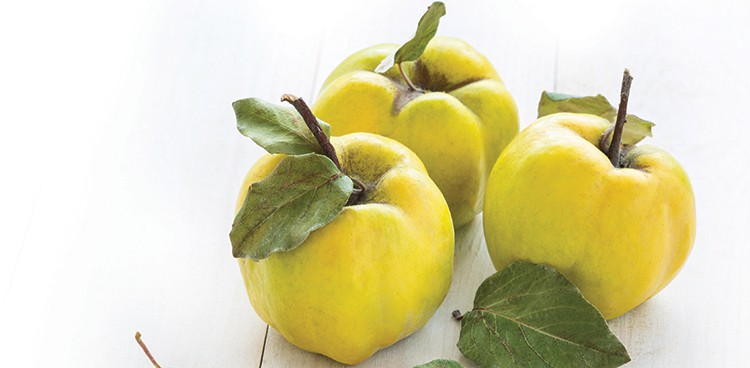
The Great 28 is featured in our Cheese+ 2017 issue. Check out 27 other pairings here.
In some versions of ancient scripture, it was not an apple that tempted Eve in the Garden of Eden—but rather a quince. Perhaps she was drawn to its alluring tropical scent, although the raw fruit’s overwhelming astringency might have surprised her. It was the Romans who learned to tame that tartness by cooking it down into a delightfully gelatinous conserve, leading to quince’s exploding popularity. Hailed as protection against the Black Death and one of the first fruits English settlers brought to America, quince was all the rage for centuries.
At some point, though, the fruit fell out of favor. “Today most people don’t know anything about [quinces],” says Bob Brown of Brown’s Fruit Farm in Waterport, N.Y. “They’ve heard of them or their grandparents have, but you don’t find them on the shelf.” Indeed, the misshapen yellow orbs seem a fond memory; my mother-in-law remembers her great-grandmother keeping an ambrosial quince in her unmentionables drawer.
As Americans became increasingly enamored with fast and ready-made foods, did we lose patience for a fruit that must be cooked? Today only 200 acres are farmed commercially in the US. However, the past few years have seen a resurgence of quince products: preserves, salsas, infused vinegars, even beer. With a renewed national focus on foods that take time and care—and on abandoned quince trees in American backyards just waiting to be plucked—it’s high time to fete Eve’s favorite fruit.
Poached Quince
Simmering deepens quince’s delicate apple- and pear-like flavors and amplifies luxe pineapple and guava aromas. Toss slices in citrus juice (like apple, quince can oxidize quickly) then poach them in white wine seasoned with orange zest, vanilla, sugar, and cardamom pods. Rich, buttery cheeses—washed-rind buffalo’s milk Quadrello di Bufala or soft-ripened Waldo Smog—bring boozy flavors forward, which temper the curds’ otherwise bold finish. And don’t toss the leftover syrup: It’s destined for a cocktail. (Quince Alexanders, anyone?)
Recommended Pairings
Fuzzy Udder Creamery Waldo Smog + poached quince
Caseificio Quattro Portoni Quadrello di Bufala + poached quince
Membrillo
Poached quince, when pureed and baked, becomes a dense, deep crimson jelly that can be sliced like old-school Thanksgiving cranberry sauce. (No additional thickeners are needed, thanks to the fruit’s high pectin content.) We love jammy, pulpy, fruit-forward Santa Teresa membrillo imported from Spain. Traditionally paired with salty Manchego, it adds refined sweetness and bite to gooey bloomy-rind cheeses like mushroomy, pungent Bûche de Chèvre or creamy Merze Tate.
Recommended Pairings
Xavier David Bûche de Chèvre + Santa Teresa Membrillo
Dancing Goat Creamery Merze Tate + Santa Teresa Membrillo
Quince Cider
Vintners are reintroducing quince to American palates. At Eaglemount Wine & Cider in Washington State, owner Trudy Davis started making quince cider after stumbling upon the fruit during a farm visit. “It was captivating,” she says. “It was so fragrant. I knew it was going to [become] something extraordinary.” This bouquet also inspired Jonathan Oakes, co-owner and winemaker at Leonard Oakes Estate Winery, to experiment. Before and after fermentation, he adds enzymes to enhance the terpenes—plant-oil building blocks—liberating aromas and ensuring a noseful with every sip. “Quince adds middle-palate astringency and bitterness,” Oakes says. “I like [it with] hard or fragrant cheeses that bring out the aroma component, because it jumps out of the glass.” Davis suggests aged cheddar, as quince has “a luscious flavor [that] really goes well with a little bit of tang.”
Recommended Pairings
Ford Farm Wookey Hole Farmhouse Cheddar + Eaglemount Wine & Cider Quince Cider
Les Fromagers du Mont Royal Le Napoléon + Leonard Oakes Estate Winery Eloquince Cider
Feature Photo Credit: Melnikof/iStockphoto.com



